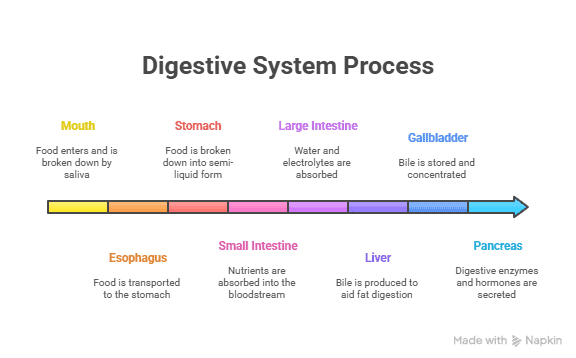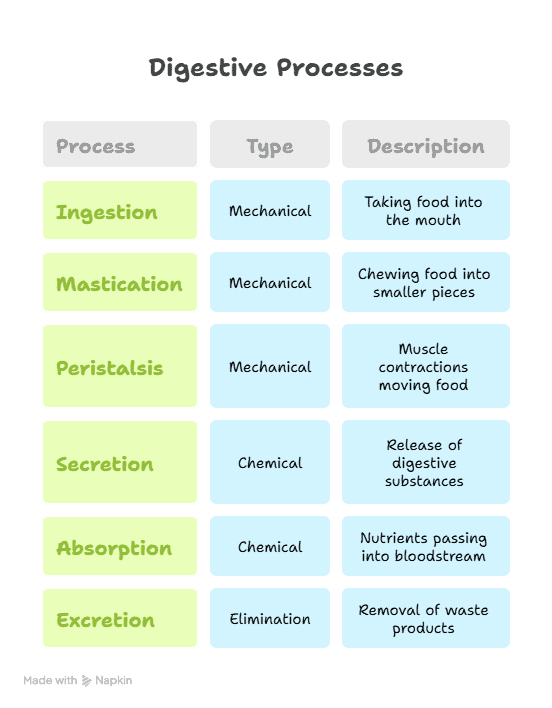Welcome to our learning module on the Digestive System! In this module, we will explore how our bodies break down food to obtain the nutrients we need to maintain good health. The digestive system is composed of numerous organs that work together to convert food into energy that our bodies can utilize.
Objectives:
- Understand the different organs in the digestive system and their functions.
- Learn how food is broken down and absorbed by the body
- Explore the importance of a healthy diet for proper digestion
- Identify common digestive problems and how to prevent them
Section 1: What is the Digestive System?
The Digestive System is a group of organs that work together to break down food into nutrients that our bodies can use. These organs include the mouth, esophagus, stomach, small intestine, and large intestine. Each organ has a specific role in the digestive process.
Overview of the Digestive System
The mouth chews food and mixes it with saliva, which helps break it down. The esophagus is a long tube that carries food from the mouth to the stomach. The stomach uses acids and enzymes to break down food further.
The small intestine absorbs nutrients from the food, while the large intestine absorbs water and helps eliminate waste. All these parts work together to keep our bodies healthy and nourished.
Importance of the Digestive System
The digestive system is crucial because it enables our bodies to break down food and absorb essential nutrients. Without a properly functioning digestive system, our bodies would be unable to obtain the energy and vitamins they need to stay healthy.
It also plays a key role in eliminating waste products that our bodies no longer need. The digestive system comprises several organs, including the stomach, intestines, and liver, that work together to ensure proper digestion of food.
Common Digestive System Disorders
Several common disorders can affect the digestive system.
- One of the most well-known is acid reflux, where stomach acid flows back up into the esophagus, causing heartburn.
- Another common disorder is irritable bowel syndrome (IBS), which can cause stomach pain, bloating, and changes in bowel habits.
- Crohn’s disease and ulcerative colitis are two types of inflammatory bowel disease that can cause inflammation and ulcers in the digestive tract.
- Celiac disease is a condition where the body cannot tolerate gluten, a protein found in wheat and other grains.
These disorders can significantly impact a person’s quality of life and may require medical treatment.
Games and Activities
- Digestive System Quiz
- Vocabulary for Digestive System Hangman Game
- Flashcards for the Digestive System
Section 2: Digestive System Organs

| Organ | Definition |
|---|---|
| Mouth | The entry point of digestion where food is ingested and broken down by enzymes in saliva. |
| Esophagus | A muscular tube that transports food from the mouth to the stomach through peristalsis. |
| Stomach | An organ that secretes gastric juices to break down food into a semi-liquid form for further digestion. |
| Small Intestine | The primary site of nutrient absorption in the digestive system, where enzymes break down food molecules. |
| Large Intestine | Also known as the colon, this organ absorbs water and electrolytes from indigestible food matter. |
| Liver | An essential organ that produces bile to aid in the digestion and absorption of fats. |
| Gallbladder | A small organ that stores and concentrates bile produced by the liver until it is needed for digestion. |
| Pancreas | An organ that secretes digestive enzymes and hormones to regulate blood sugar levels. |
Mouth and Esophagus
The mouth and esophagus play essential roles in the digestion process. In the mouth, food is chewed by the teeth and mixed with saliva, which contains enzymes that aid in breaking down the food.
The tongue helps push the food towards the back of the mouth, where it is swallowed and enters the esophagus. The esophagus is a long tube that connects the mouth to the stomach. It uses a squeezing motion called peristalsis to push the food down into the stomach for further digestion.
Overall, the mouth and esophagus work together to start the process of breaking down food so that it can be absorbed and used by the body.
Stomach and Small Intestine
The stomach and small intestine play essential roles in the digestion process. The stomach is like a blender that churns and mixes food with acids and enzymes to break it down into smaller pieces.
It also kills any harmful bacteria that may be in the food we eat. Once the food is partially digested in the stomach, it moves into the small intestine.
The small intestine is where most digestion and nutrient absorption take place. Enzymes from the pancreas and bile from the liver help break down food into nutrients that our bodies can use.
The small intestine is lined with tiny finger-like projections called villi that absorb nutrients and send them into the bloodstream to be used by the body.
Large Intestine and Rectum
The large intestine and rectum play essential roles in our digestive system. The large intestine absorbs water and minerals from the food we eat, making our poop solid. It also helps remove waste products from our bodies.
The rectum is like a storage area for poop before it leaves our body through the anus. Both the large intestine and the rectum work together to help us digest food and eliminate waste. It’s essential to take care of these parts of our body by eating healthy foods and drinking plenty of water.
Games and Activities
- Hangman Game on Digestive System Organs
- Digestive System Organs Flashcards
- Quiz on the Digestive System Organs
Section 3: Digestive System Processes
Mechanical Digestion
In the digestive system, mechanical digestion is the process of breaking down food into smaller pieces so our bodies can absorb nutrients. This process starts in the mouth, where we chew our food with our teeth. The teeth grind the food into smaller pieces, making it easier for our bodies to digest.
Once the food is chewed, it travels down the esophagus and into the stomach. In the stomach, muscles contract and relax to mix the food with stomach acids. This helps further break down the food into smaller pieces. Finally, the food enters the small intestine, where it is mixed with enzymes and bile to facilitate digestion.
Chemical Digestion
Enzymes play a key role in chemical digestion. They are like little helpers that break down the food we eat into smaller pieces, allowing our bodies to absorb the nutrients more efficiently. Each enzyme has a specific function, such as breaking down proteins, carbohydrates, or fats.
For example, amylase helps break down carbohydrates, while protease breaks down proteins. Without enzymes, our bodies would be unable to digest food properly, and we wouldn’t receive the necessary nutrients to stay healthy.
Absorption and Elimination
Nutrients are absorbed in the digestive system through a process called digestion. When we eat food, it gets broken down into smaller particles by our teeth and stomach acids. These particles then travel to the small intestine, where they are absorbed into the bloodstream.
Our body then utilizes nutrients such as vitamins, minerals, proteins, and carbohydrates for energy and growth.
Waste, on the other hand, is eliminated through the process of excretion. Waste products from the food we eat, such as fiber and undigested particles, are moved through the large intestine and eventually expelled from our body as feces.
It is essential to have a healthy digestive system to ensure that nutrients are correctly absorbed and waste is eliminated efficiently.

| Process | Type | Definition |
|---|---|---|
| Ingestion | Mechanical | The process of taking food into the mouth. |
| Mastication | Mechanical | The process of chewing and breaking down food into smaller pieces. |
| Peristalsis | Mechanical | The involuntary muscle contractions that move food through the digestive tract. |
| Secretion | Chemical | The release of digestive enzymes, acids, and other substances to aid in digestion. |
| Absorption | Chemical | The process of nutrients passing through the walls of the digestive tract into the bloodstream. |
| Excretion | Elimination | The removal of waste products from the body through the rectum and anus. |
Games and Activities
- Digestive Process Flashcards
- Digestive Process Vocabulary Hangman Game
- Quiz on the Process of the Digestive System
Conclusion
You’ve completed the learning module on the Digestive System! During this module, you’ve learned the following objectives:
- The main organs of the digestive system
- How food moves through the digestive tract
- The role of enzymes in digestion
- The importance of a healthy diet for proper digestion
Now that you’ve completed this module, you’ve a better understanding of how your digestive system works and how to maintain its health. Keep learning and exploring the fascinating world of anatomy!
What to Study Next?
It would be an excellent idea for you to study the Endocrine system next. This system controls hormones and how your body functions. It is essential to understand how it works to maintain good health.
By studying the Endocrine system, you will gain a deeper understanding of your body and how it works in conjunction with the digestive system. Keep up the good work!
